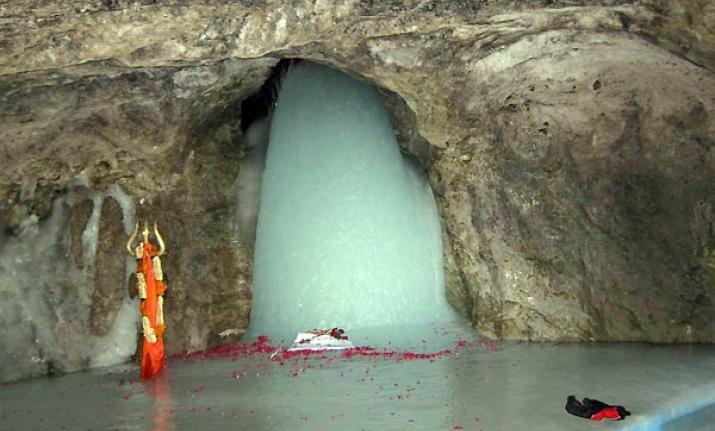
Registration for Amarnath Yatra temporarily suspended over COVID fears
Until the 1950s, only about 4,500 pilgrims used to visit the cave and the pilgrimage would be a fortnightly affair. In subsequent years, its duration increased from two to six weeks

The Shri Amarnathji Shrine Board (SASB) has “temporarily suspended” registration for Hindu pilgrims undertaking the 56-day yatra this year.
The SASB cited the spike in COVID-19 cases as the primary reason behind its decision: “In view of evolving COVID situation in the country & (and) the need to take all necessary precautionary measures, registration for Shri Amarnath ji Yatra is being temporarily suspended. The situation is being constantly monitored and it would be reopened once the situation improves.”
The J&K administration said that it “has taken a large number of measures to reduce the spread of infection through night curfews, 50% reduction in shop opening, 50% restriction on public transport passengers, closure of schools and colleges, etc”. It further said: “It was decided to defer registrations for the Amarnathji Yatra 2021. The Board had commenced registrations on 1st April, and the arrangements were on track since February 2012 for a successful conduct of the pilgrimage.”
Also read: Can PDP survive the new paradigm of Kashmir politics?
The pilgrimage to the 3,880-metre-high Amarnath shrine is scheduled to commence simultaneously from Pahlagam and Baltal, in Kashmir, on June 28 and expected to culminate on August 22.
Prominent health professionals like Dr Yasir Wani argue that it is next to impossible to maintain COVID-19 appropriate behaviour during big gatherings, especially during massive religious pilgrimages. “Suspension of the registration of the yatris [pilgrims] is a welcome step. This was necessary in the current scenario when our healthcare apparatus is being stretched to its limits due to the massive spike in COVID cases,” Dr Yasir, a leading consultant paediatrician with Jammu and Kashmir Health Services, told The Federal.
This year, online registration for the pilgrimage to the Himalayan cave shrine of Amarnath from the twin routes of Pahalgam in south Kashmir’s Anantnag district and Baltal in central Kashmir’s Ganderbal district commenced on April 15. The administration is organising the biggest-ever pilgrimage this year and making arrangements to host as many as 6,00,000 pilgrims.
Also read: Kashmir’s Mughal-era camelback-shaped bridge restored to its glory
Given the current grave situation when India is logging more than 300,000-plus fresh cases of coronavirus and related 2100-plus deaths on a daily basis, many in Jammu and Kashmir are demanding cancellation of the pilgrimage – for the safety of the pilgrims as well as the natives – or favouring curtailment of the duration and limiting the number of pilgrims.
Haziq Qadri, a political and cultural commentator, said that it was time to “suspend all tourism-related activities” in Jammu and Kashmir. While favouring outright cancellation of the pilgrimage and regular tourism activities during the infection surge, Qadri said: “The healthcare system in Kashmir is fragile and it would crumble soon if tourists keep adding to the rising COVID cases. If the government can shut shops, why not suspend all kinds of tourism for now?”
On March 25, the J&K administration in a controversial move threw open Srinagar’s famed Tulip Garden, flaunted as Asia’s biggest garden, with 1.5 million tulips of over 60 varieties, with the aim to showcase normalcy in post-August 5 Kashmir. Qadri maintained that it was only prudent “to close places like Tulip Garden also”.
One of the demands in Kashmir is to restrict the number of pilgrims and the duration of the pilgrimage.
Also read: Bollywood aims to shoot more films in Kashmir, but can it improve its image?
Mohammad Yusuf Tarigami, leader of the Communist Party of India (Marxist) and a former legislator from south Kashmir’s Kulgam constituency, told The Federal, also said the flow of yatris should restricted.
Khushboo Mattoo, a resident of Jammu, tweeted: “Dear J&K Government, I do not want to die. Just like me, there are many others who also don’t wan’t to die. Tourism, yatra, Vaishno Devi pilgrimage should be suspended immediately. GMC or other hospitals will not be able to take the load. All hell will break loose #SAVEJnK #SoSJnK.”
Last year, the administration’s decision to throw open the region for tourism activities and the Amarnath pilgrimage had stirred a heated debate. At the time, it was reported that the pilgrimage would be conducted with not more than 500 pilgrims allowed per day. In a high-level meeting in North Block, New Delhi, it was resolved that the pilgrimage to the cave, considered sacred by devotees of Lord Shiva, would be allowed for a fortnight starting July 21.
Until the 1950s, only about 4,500 pilgrims used to visit the cave and the pilgrimage would be a fortnightly affair. In subsequent years, its duration increased from two to six weeks. The pilgrimage had been cancelled in 2020 due to the coronavirus pandemic and curtailed in 2019 ahead of taking away of J&K’s semi-autonomous status and statehood (revocation of Article 370). As many as 3,42,883 people had visited the cave shrine in 2019. In 2018, a total of 2,85,006 pilgrims had undertaken the yatra. In 2013, according to government figures, a total of 3.5 lakh pilgrims had visited the cave.
“These are obviously double standards. For one community, the J&K administration has barred all social, religious, political and recreational activities, citing COVID-19 pandemic as a reason. On the other hand, the same administration is allowing a religious pilgrimage for another community and throwing open parks and gardens for tourists,” Khurram Parvez, coordinator J&K Coalition of Civil Society (JKCCS,) told The Federal in Srinagar.
Meanwhile, Jammu and Kashmir is also witnessing a massive spike in the number of COVID-19 cases. On April 22, the region recorded about 2,000 cases and eight related deaths. A day before, over 2,200 cases and 13 deaths were reported.


